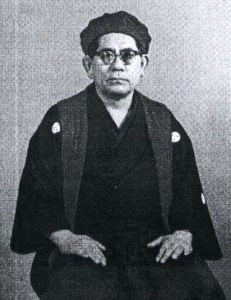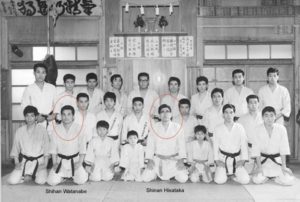All information found on this website is respectfully dedicated to the life and memory of Shinan Dr. Masayoshi Kori Kudaka (Hisataka) without whose dedication to the martial arts and the improvement of the person we would not be here.
Kaiso Masayoshi Hisataka
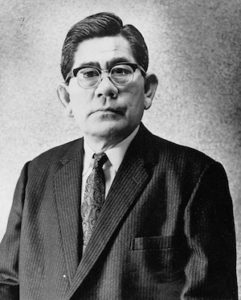 Shinan Kori Hisataka (Kudaka in Okinawa) was born on 22 April 1907 in Shuri, Okinawa. Although now a part of the Naha Metropolitan area, Shuri was the original capital of Okinawa, location of the Shuri Castle and home to most of the Ryukyu (Okinawan) aristocracy. His name at birth was Seiki Kudaka (pronounced Masayoshi Hisataka in Japanese), and he was a third generation descendant of Feudal Lord Seison Toguchi, descendant of SEIWA the fifty sixth Emperor of Japan and a member of the Ryukyu (Okinawan) nobility who was made lord of Kudaka Island in recognition for his services to the then Kingdom of Ryukyu. As was the tradition, Toguchi then adopted the name Kudaka as his own. The first name Kori was taken by Shinan Kudaka (Hisataka) later in life–a custom among some senior martial arts practitioners.
Shinan Kori Hisataka (Kudaka in Okinawa) was born on 22 April 1907 in Shuri, Okinawa. Although now a part of the Naha Metropolitan area, Shuri was the original capital of Okinawa, location of the Shuri Castle and home to most of the Ryukyu (Okinawan) aristocracy. His name at birth was Seiki Kudaka (pronounced Masayoshi Hisataka in Japanese), and he was a third generation descendant of Feudal Lord Seison Toguchi, descendant of SEIWA the fifty sixth Emperor of Japan and a member of the Ryukyu (Okinawan) nobility who was made lord of Kudaka Island in recognition for his services to the then Kingdom of Ryukyu. As was the tradition, Toguchi then adopted the name Kudaka as his own. The first name Kori was taken by Shinan Kudaka (Hisataka) later in life–a custom among some senior martial arts practitioners.
Shinan Kori Kudaka (Hisataka, b. 1907 – d. 1988) was the founder of Shorinjiryu Kenkokan Karatedo (少林寺流拳行館唐手道), a style he based on his studies of various Ryukyu (Okinawan), Japanese and Chinese forms of martial arts. Shinan Kudaka was introduced to Karatedo and other forms of Ryukyu (Okinawan) martial arts from an early age. His first instructors were his father, grandfather and uncle who introduced him to the family form of Okinawa-Te known as Kudaka-ryu (久高流), along with the familial form of Ryukyu Kobu-Jutsu (琉球古武術) called Shishiryu no BO (獅子流の棒).
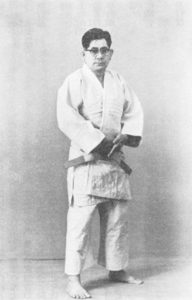 Recent research suggests that Shinan Kudaka (Hisataka) may have attended the Naha Municipal Commercial School (Marine College). At the time that Shinan Kudaka was a student there, Karate was in the process of being introduced to the Okinawan school system, principally through the efforts of Master Anko Itosu (Shorinjiryu). The karate teacher at the Naha Commercial School was Master Kanryo Higaonna (Shoreijiryu) who was assisted by Master Chojun Miyagi. Master Miyagi took over as principal karate teacher at this school following Higaonna’s death. This is where Shinan Kudaka is most likely to have met Masters Higaonna and Miyagi, and is the probable original source of the Kata Sanchin as it relates to Shorinjiryu.
Recent research suggests that Shinan Kudaka (Hisataka) may have attended the Naha Municipal Commercial School (Marine College). At the time that Shinan Kudaka was a student there, Karate was in the process of being introduced to the Okinawan school system, principally through the efforts of Master Anko Itosu (Shorinjiryu). The karate teacher at the Naha Commercial School was Master Kanryo Higaonna (Shoreijiryu) who was assisted by Master Chojun Miyagi. Master Miyagi took over as principal karate teacher at this school following Higaonna’s death. This is where Shinan Kudaka is most likely to have met Masters Higaonna and Miyagi, and is the probable original source of the Kata Sanchin as it relates to Shorinjiryu.
As a teenager, Shinan Kudaka spent some time in the southern Japanese island of Kyushu, and is said to have learnt the art of jujutsu while there. While little verifiable information is available about this time frame, one look at a Shorinjiryu practitioner in action will confirm the influence of grappling on our style. This may also have been gained from the native Ryukyu (Okinawan) form of grappling known as tegumi (also called Ryukyu “Okinawa” Sumo) and Shinan Kudaka was a YOKOZUNA or Grand Champion in Ryukyu SUMO wrestling, a sport at which Shinan Kudaka was said to have excelled. Research by such historians as Shihan Patrick McCarthy suggests that tegumi was in fact one of the original arts that comprised karate along with Tigua, the art of percussive impact, and Tuidi, the art of nerve striking. Most modern Japanese styles focus only on the percussive impact component, but the grappling is still obvious in styles like Shorinjiryu Kenkokan Karate-do.
Another early teacher of Shinan Kori Kudaka (Hisataka) was the reclusive weapons master, and former Okinawan police commissioner, Sanda “Ufuchiku” Kanagusuku (1841-1921). As Shinan Kori Kudaka’s father had died whilst he was young, Ufuchiku Kanagusuku was petitioned by the Kudaka family to teach weapons, in particular: sai, bo and jo, to the young prodigy.
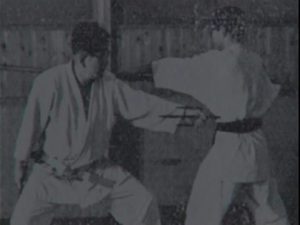 Perhaps the main teacher of Shinan Kudaka was Master Chotoku Kyan (1870-1945), a student of Anko Azato, Sokon Matsumura, Kokan Oyadomari and Kosaku Matsumora. Master Kyan is credited with founding a style he called Sukunaihayashi (pronounced Shorinjiryu in Japanese), and for introducing such innovations as the vertical fist, the extended use of the hips in punching and kicking, and angular movement for evasion and defense. It is through the Master Kyan lineage that several of our current Kata have evolved, particularly Bassai, Seisan, Chinto and Kusanku. It is also thought that the form of Nijushiho practiced in Shorinjiryu was passed from Grand Master Azato to Master Kyan and then onto Shinan Kudaka having been modified by Grand Master Azato to include principles of defense against bladed weapons. This is something Grand Master Azato derived from his own studies of Jigenryu Kenjutsu, and his successful unarmed encounter against a Japanese samurai.
Perhaps the main teacher of Shinan Kudaka was Master Chotoku Kyan (1870-1945), a student of Anko Azato, Sokon Matsumura, Kokan Oyadomari and Kosaku Matsumora. Master Kyan is credited with founding a style he called Sukunaihayashi (pronounced Shorinjiryu in Japanese), and for introducing such innovations as the vertical fist, the extended use of the hips in punching and kicking, and angular movement for evasion and defense. It is through the Master Kyan lineage that several of our current Kata have evolved, particularly Bassai, Seisan, Chinto and Kusanku. It is also thought that the form of Nijushiho practiced in Shorinjiryu was passed from Grand Master Azato to Master Kyan and then onto Shinan Kudaka having been modified by Grand Master Azato to include principles of defense against bladed weapons. This is something Grand Master Azato derived from his own studies of Jigenryu Kenjutsu, and his successful unarmed encounter against a Japanese samurai.
In the late 1920’s, Shinan Kori Kudaka (Hisataka) completed his compulsory military service, and then left to return to Okinawa. In 1929-30, he travelled to Taiwan along with his teacher, Master Chotoku Kyan and Master Ryosei Kuwae. There the three Okinawan karateka toured, demonstrated and learned from local practitioners. In one famous incident, the three gave a demonstration at the Taipei Botokuden (hall of martial virtues), where Master Kyan fought a challenge against a senior judoka named Shihan Shinzo Ishida who was a one of the strongest Judoka in Japan at that time.
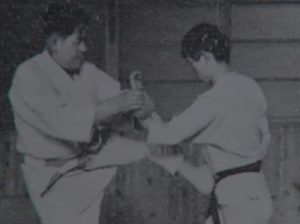 At the same event, Shinan Kudaka fought a challenge match against a female Naginata master. The naginata (halberd) is an ancient samurai weapon, but in recent times has become the preferred weapon of women martial artists. This particular Naginata expert was so skilled that she had previously defeated the famous Kendo master, Junzo Sasamori (literally the co-author of the best book on Kendo). Shinan Kudaka fought the challenge, and won, utilizing a BO or wooden staff. Following their tour together, Master Kyan returned to Okinawa, and it was following his return from this trip that he introduced the Kata Ananku. Master Kuwae, the last student of the great “Bushi” Sokon Matsumura is believed to have stayed in Taiwan.
At the same event, Shinan Kudaka fought a challenge match against a female Naginata master. The naginata (halberd) is an ancient samurai weapon, but in recent times has become the preferred weapon of women martial artists. This particular Naginata expert was so skilled that she had previously defeated the famous Kendo master, Junzo Sasamori (literally the co-author of the best book on Kendo). Shinan Kudaka fought the challenge, and won, utilizing a BO or wooden staff. Following their tour together, Master Kyan returned to Okinawa, and it was following his return from this trip that he introduced the Kata Ananku. Master Kuwae, the last student of the great “Bushi” Sokon Matsumura is believed to have stayed in Taiwan.
Shinan Kudaka traveled on to mainland China, and as far afield as Burma, Thailand, Afghanistan, Russia and Mongolia, in each location furthering his studies and skills as a martial artist. Shorinjiryu Kenkokan Karatedo is a rather eclectic combination of techniques, and one can only imagine where some ideas originated from during Shinan Kudaka’s travels. Of obvious influence were some of the northern Chinese styles, particularly Baji Quan (Hakkyoku Ken in Japanese) and Shaolin Long Fist. In 1932, Shinan Kudaka demonstrated at a martial arts festival celebrating the confederation of the Manchurian state. At the time, he demonstrated the Kudaka family version of the KATA Kudaka no Kusanku to the accompaniment of a Song of National anthem “Kimigayo”. This KATA is also sometimes known as Happo-ate, meaning eight directional striking.
Before World War II Shihan Kudaka was invited by the Chinese Martial Arts organizations from China and had given special Karate demonstrations, in the presence of the “Last Emperor FUGI” at the official Opening Ceremony for the newly establish “country MANCHURIA”. Thereafter, where he had spent his years in order to further develop BOJUTSI and JUJUTSU.
At some point in the 1930’s, Shinan Kudaka returned to Okinawa and Japan. During this time Shinan Kudaka spent a year in Tokyo, training at the home of Judo, the Kodokan, under the great master Sanpo Toku (known as “the devil of the Kodokan”). In only one year, Shinan Kudaka attained the rank of Yondan, or 4th Dan. Also during the 1930’s, Shinan Kudaka toured Japan with his teacher, Master Chotoku Kyan. It is said that he fought many challenges, never losing. In one story, reported in Scientific Karatedo, Shinan Kudaka broke a wooden block that even a powerful swordsman could not break. The swordsman challenged Shinan Kudaka to a duel, and Shinan Kudaka defeated him, weaponless.
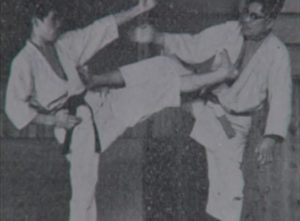 In the late 1930’s, following the outbreak of hostilities between Japan and China, Shinan Kudaka was stationed in Manchuria, then occupied by the Japanese, as a Station Master in the Railway system. Over the following years, he was located in several cities, including Bakudashi, Sarachi and others. In one location, the deputy governor at the time was the great martial artist, Master Minoru Mochizuki (1907-2004) who together with Jigoro Kano, the Founder of Judo, had made the first public demonstration of Judo and also the first public demonstration of Aikido in Europe.
In the late 1930’s, following the outbreak of hostilities between Japan and China, Shinan Kudaka was stationed in Manchuria, then occupied by the Japanese, as a Station Master in the Railway system. Over the following years, he was located in several cities, including Bakudashi, Sarachi and others. In one location, the deputy governor at the time was the great martial artist, Master Minoru Mochizuki (1907-2004) who together with Jigoro Kano, the Founder of Judo, had made the first public demonstration of Judo and also the first public demonstration of Aikido in Europe.
Master Mochizuki was a highly ranked practitioner of Judo and Aikido, having studied under the founders of each system, Founder Jigoro Kano (Judo) and Founder Morihei Ueshiba (Aikido). As a matter of interest, Master Mochizuki’s first Judo teacher was Great Master Sanpo Toku. Master Mochizuki and Kaiso Kudaka trained regularly at a local Budokan, and to this day the karate taught in Yoseikan Budo (Master Mochizuki’s composite system comprised of techniques from Judo, Aikido, Karate and other arts) is based on a form taught by Shinan Kudaka being Kudaka-Ryu, also known as Happoken.
According to Shinan Kudaka’s son, Hanshi Masayuki Kukan Hisataka, another influence on Shinan Kudaka was an elderly Chinese master that he had employed at one of the railway stations he was overseeing. This master taught Shinan Kudaka a Chinese style known as Baji Quan (pronounced Hakkyoku-ken in Japanese). Baji is known as being a violent and explosive martial art, and is characterized by techniques such as foot stamping (fumikomi ashi) and weight dropping (otoshi mi). These 2 methods of power generation are quite representative of Shorinjiryu Karate.
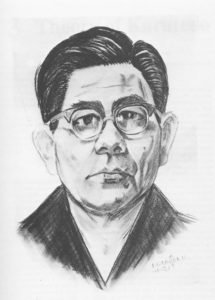 Following the war, Shinan Kudaka and his family were repatriated to Japan, via Beijing. On returning to Japan, Shinan Kudaka found the country to be demoralized, and the young people were suffering from low employment rates. He established Shorinjiryu Kenkokan Karate as a means to promote health and discipline, with his dojo initially located in Hamada village, on the southern island of Kyushu. Within the next few years, he relocated his family and dojo to Tokyo, principally for the reasons of better educating his children. The dojo was first established in Setagaya Ward, before moving in 1955 to its current location in the Kikuicho district of Shinjuku Ward, Tokyo.
Following the war, Shinan Kudaka and his family were repatriated to Japan, via Beijing. On returning to Japan, Shinan Kudaka found the country to be demoralized, and the young people were suffering from low employment rates. He established Shorinjiryu Kenkokan Karate as a means to promote health and discipline, with his dojo initially located in Hamada village, on the southern island of Kyushu. Within the next few years, he relocated his family and dojo to Tokyo, principally for the reasons of better educating his children. The dojo was first established in Setagaya Ward, before moving in 1955 to its current location in the Kikuicho district of Shinjuku Ward, Tokyo.
The opening ceremony of the new dojo was a special affair, with special guests such as Master Shinki Gima, an Okinawan master who had made the first public demonstration of karate in Japan, together with Master Gichin Funakoshi. Both Masters were Shorinjiryu Karate Practitioners and Master Gima was also among the first group of people to be awarded a black belt in karate, by Master Gichin Funakoshi.
It is not known how often Shinan Kudaka returned to Okinawa, but since his main teacher, Master Chotoku Kyan, had died in 1945 while Shihan Kudaka was still in China, his future source of inspiration was to be his own studies and knowledge from his main influences: Okinawa-te and the Karate of Anko Azato and Chotoku Kyan. Both are masters of Shorinjiryu Karate, Judo, Jujutsu and Aikijutsu, and the martial arts of China.

It is known that Shinan Kudaka returned to Okinawa in 1953 for the funeral of Chojun Miyagi, and also for the foundation of an Okinawan Karate Federation, probably in 1957. Shihan Choushin Chibana the Founder of Shorinryu (小林流), Shihan Shoshin Nagamine the founder of Matsubayashi-ryu (松林流) and another student of Chotoku Kyan, recounted in one of his books that Shinan Kudaka was “a friend since childhood”, and visited him in the 1970’s.
In the early 1960’s, Shinan Kudaka published a small book in Japanese entitled: “Shorinjiryu Kenkokan Karate: History and Theory of the Art”, this book is one of the few sources of information written by this martial artist available to modern students, albeit in a limited manner. The book does not have a publication date, but it believed to be circa 1964. Pictures of Shinan Kudaka in that book depict him wearing a Judo-like gi, and a red and white belt.

In the 1960’s, Shinan Kudaka (Hisataka) sent several of his outstanding young students to North America to introduce Shorinjiryu Kenkokan Karate-do. Most of them settled in New York, Baltimore or Montreal. These people included his son, So Shihan Masayuki Kukan Hisataka, Shihan Hisanobu Yamazaki , Shihan Shunji Watanabe, Shihan Shigeru Ishino, Shihan Minoru Morita, Shihan Naoyuki Okabe, Shihan Yashiro Ishigami, Shihan Hishiaki Sakamoto, Shihan Fujio Monjiyama amongst others. Many of them are still resident in North America to this day. In 1974, Shinan Kudaka retired from day-to-day teaching, recalling his son, Hanshi Masayuki Kukan Hisataka, to Japan to take over as head instructor. Shinan Kudaka still joined in on classes, but stood back from the administrative functions.
Shinan Masayoshi Kori Kudaka (Hisataka) passed away on 14 August 1988, leaving the Shorinjiryu Kenkokan Karatedo School in the hands of his son, So-Shihan Masayuki Kukan Hisataka.
